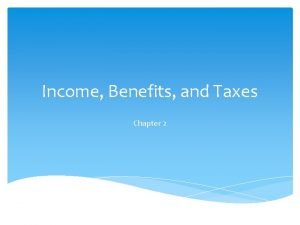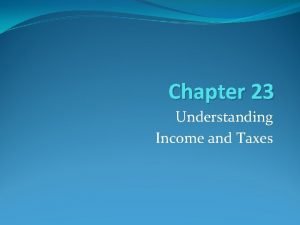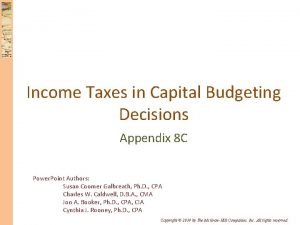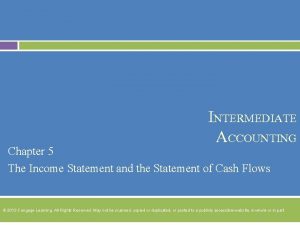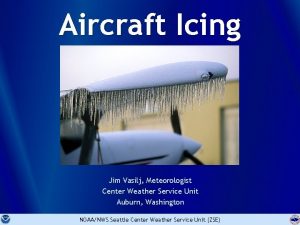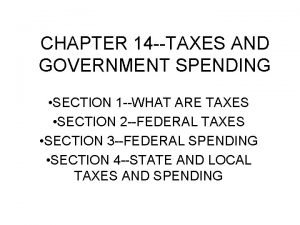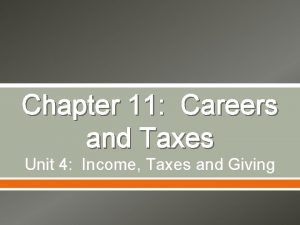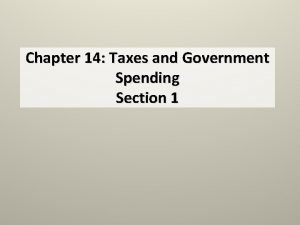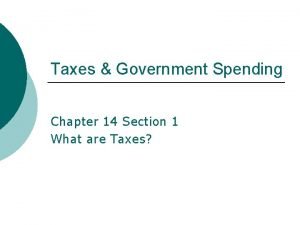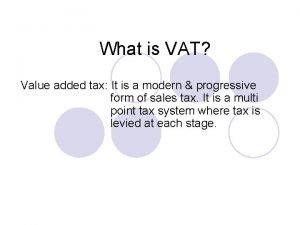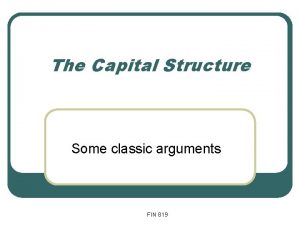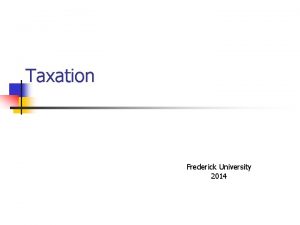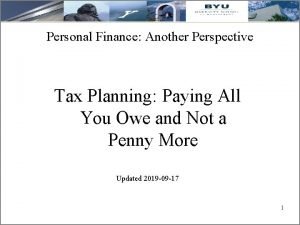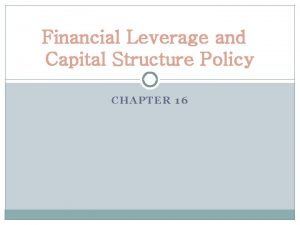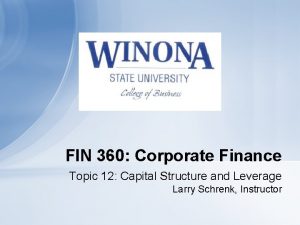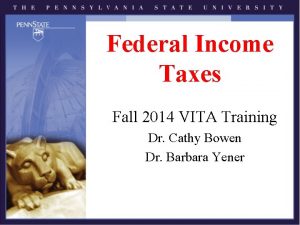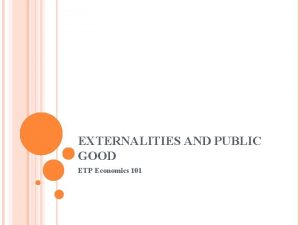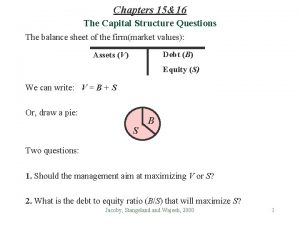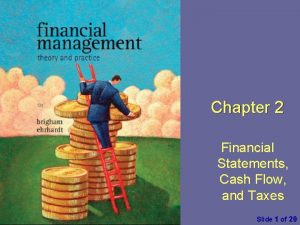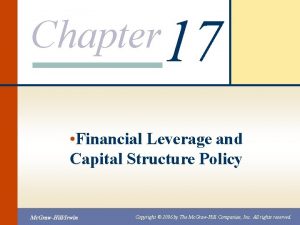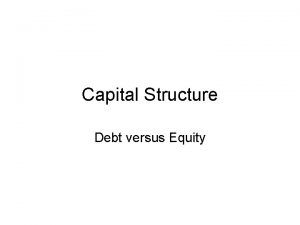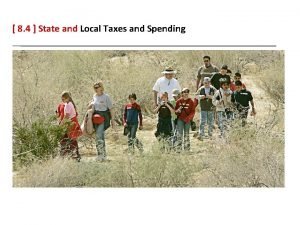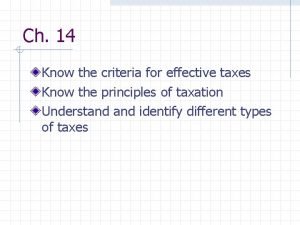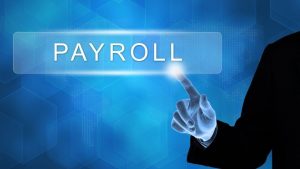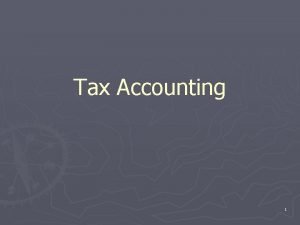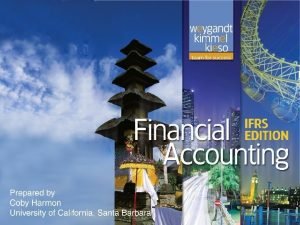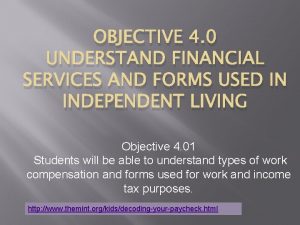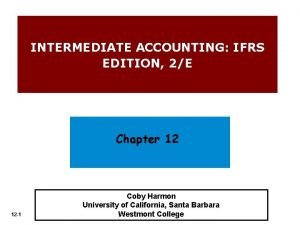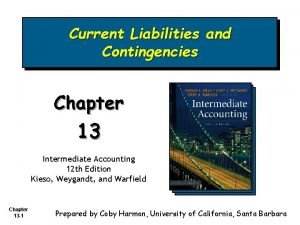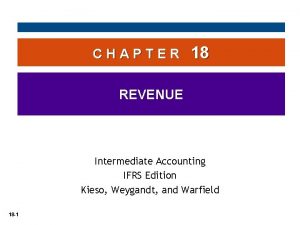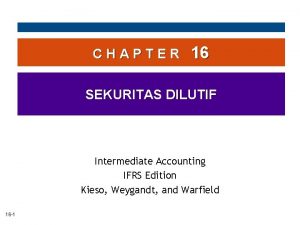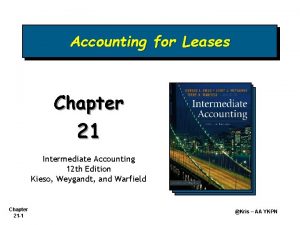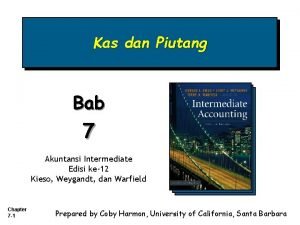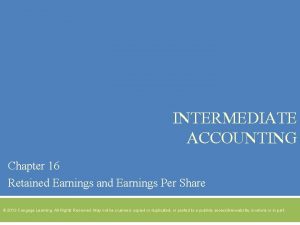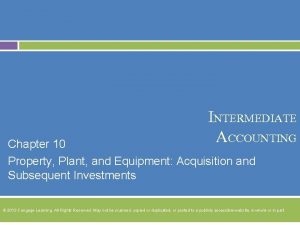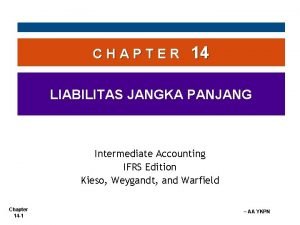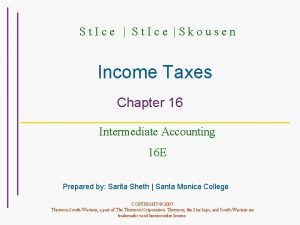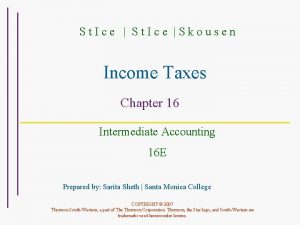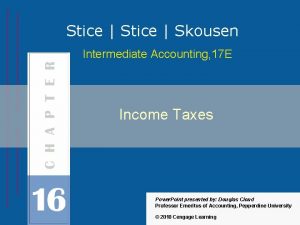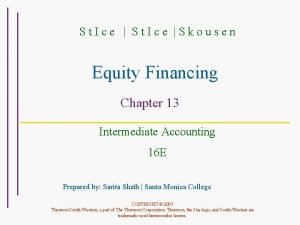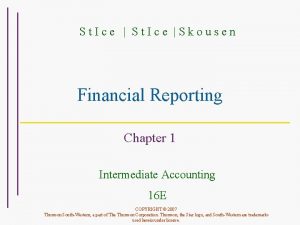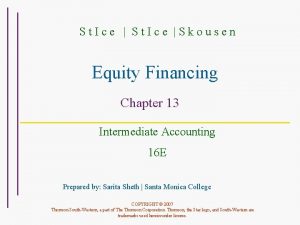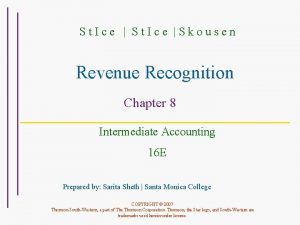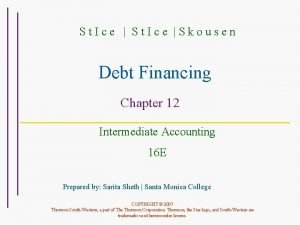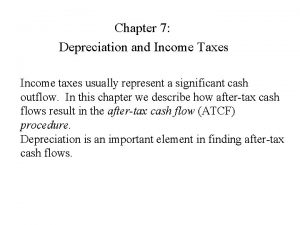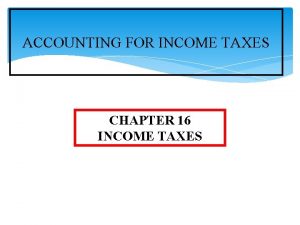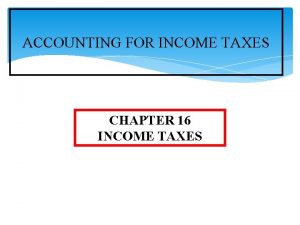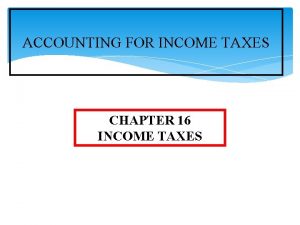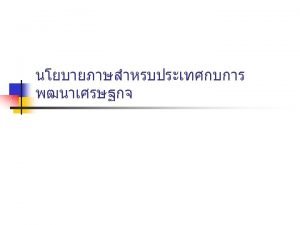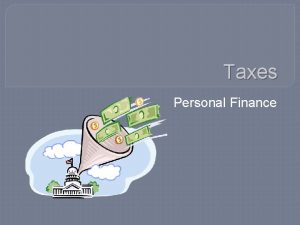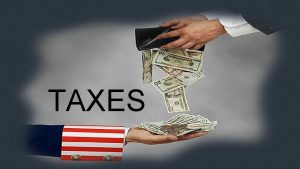St Ice Skousen Income Taxes Chapter 16 Intermediate

























































- Slides: 57

St. Ice |Skousen Income Taxes Chapter 16 Intermediate Accounting 16 E Prepared by: Sarita Sheth | Santa Monica College COPYRIGHT © 2007 Thomson South-Western, a part of The Thomson Corporation. Thomson, the Star logo, and South-Western are trademarks used herein under license.

Learning Objectives 1. Understand the concept of deferred taxes and the distinction between permanent and temporary differences. 2. Compute the amount of deferred tax liabilities and assets. 3. Explain the provisions of tax loss carrybacks and carryforwards, and be able to account for these provisions.

Learning Objectives 4. Schedule future tax rates, and determine the effect on tax assets and liabilities. 5. Determine appropriate financial statement presentation and disclosure associated with deferred tax assets and liabilities. 6. Comply with income tax disclosure requirements associated with the statement of cash flows. 7. Describe how, with respect to deferred income taxes, International Accounting Standards have converged toward the U. S. Treatment.

Overview • The primary goal of financial accounting is to provide useful information to management, stockholders, creditors, and other properly interested. • The primary goal of the income tax system is the equitable collection of revenue.

Deferred Income Tax Overview Two basic considerations in U. S. corporations computed net income. 1. How to account for revenues and expenses that have already been recognized and reported to shareholders in a company’s financial statements but will not affect taxable income until subsequent years.

Deferred Income Tax Overview Two basic considerations in U. S. corporations computed net income. 2. How to account for revenues and expenses that have already been reported to the IRS but will not be recognized in the financial statements until subsequent years.

Stop and Think This discussion mentions two sets of books the financial and the income tax records. Which ONE of the following is the most important third set of accounting records in a well-run business?

Simple Deferred Income Tax Liability • Examples: – Revenues (or gains) taxable after they are recognized for financial reporting, such as receivables from installment sales. – Expenses (or losses) deductible for tax purposes before they are recognized for financial reporting purposes, such as accelerated tax depreciation.

Simple Deferred Tax Liability In 2007, Hernandez Company earned revenues of $30, 000. Hernandez has no expenses other than income taxes. In this case, Hernandez is taxed on cash received. The company received $10, 000 in 2007 and $20, 000 in 2008. The income tax rate is 40% and it is expected to remain the same into the foreseeable future.

Simple Deferred Tax Liability Income Tax Expense Income Taxes Payable Deferred Tax Liability 12, 000 4, 000 8, 000 $30, 000 x. 40 $10, 000 x. 40 $20, 000 x. 40 Hernandez Company Income Statement For the Year Ended December 31, 2007 Revenues Income tax expense: Current Deferred Net income $30, 000 $4, 000 8, 000 $18, 000

Simple Deferred Income Tax Asset • Examples: – Expenses (or losses) that are deductible for tax purposes after they are recognized for financial reporting purposes, such as warranty expenses. – Revenues (or gains) that are taxable before they are recognized for financial reporting purposes, such as subscriptions received in advance.

Simple Deferred Tax Asset In 2007, Shah Corporation generated service revenues totaling $60, 000, all taxable in 2007. No warranty claims were made in 2007, but Gupta estimates that in 2008 warranty costs of $10, 000 will incurred for claims related to 2007 service revenues. Assume a 40% tax rate.

Simple Deferred Tax Asset Income Tax Expense Deferred Tax Asset Income Taxes Payable 20, 000 4, 000 24, 000 $30, 000 x. 40 Shah Company $10, 000 x. 40 Income Statement $20, 000 x. 40 For the Year Ended December 31, 2007 Revenues Less: Warranty Expense Income before taxes Income tax expense: Current Deferred benefit Net income $60, 000 10, 000 50, 000 $24, 000 (4, 000) 20, 000 $30, 000

Temporary Differences • Permanent Differences- Nondeductible expenses or nontaxable revenues that are recognized for financial reporting purposes but are never part of taxable income. • Temporary Differences- Differences between pretax financial income and taxable income arising from business events that are recognized for both financial and tax purposes, but in different time periods.

Stop and Think How can a company have both deferred tax assets and deferred tax liabilities at the same time?

Example of Permanent and Temporary Differences For the year ended December 31, 2007, Monroe Corporation reported net income before taxes of $420, 000. This amount includes $20, 000 of nontaxable revenues and $5, 000 of nondeductible expenses. The depreciation method used for tax purposes allowed a deduction that exceeded the book approach by $30, 000.

Example of Permanent and Temporary Differences Pretax income from income statement $420, 000 Add (deduct) permanent differences: Nontaxable revenues Nondeductible expenses (15, 000) Financial income subject to tax $405, 000 Add (deduct) temporary differences: Excess of tax depreciation over book depreciation Tax on taxable income (30, 000) taxes payable): $375, 000 x. 35 Taxable income $(20, 000) 5, 000 $131, 250

Annual Computation of Deferred Tax Liabilities & Assets • Advantages of the asset and liability method: 1. Assets and liabilities are recorded in agreement with FASB definitions of financial statement elements. 2. Method is flexible and recognizes changes in circumstances and adjusts the reported amounts accordingly. 3. Has better predictive value.

Annual Computation of Deferred Tax Liabilities and Assets Identify type and amounts of existing temporary differences. Measure the deferred tax liability for taxable temporary differences (use enacted rates). Measure the deferred tax asset for deductible temporary differences (use enacted rates). Establish valuation allowance account if more likely than not some portion or all of the deferred tax asset will not be realized.

Example 3 Deferred Tax Liability For 2007, Roland computes pretax financial income of $75, 000. The only difference between financial and taxable income is depreciation. The enacted tax rate is 40%. The 2007 tax is $24, 000 (40% of $60, 000). Financial income subject to tax Deduct temporary difference: Excess of tax depreciation ($40, 000) over book depreciation ($25, 000) Taxable income $75, 000 (15, 000) $60, 000

Example 3 Deferred Tax Liability Journal entry for 2007 Income Tax Expense Income Taxes Payable Deferred Tax Liability— Noncurrent 30, 000 24, 000 6, 000 $30, 000 – $6, 000 $15, 000 x. 40

Stop and Think How might the current and deferred income tax numbers for 2008 change if the 2008 income tax rate were 40% but Roland expected tax rates in future periods to be 30% instead of 40%.

Example 3 Deferred Tax Liability For 2008, Roland earned income of $75, 000 and the taxable income is $70, 000, or a tax of $28, 000. Financial income subject to tax Deduct temporary difference: Excess of tax depreciation ($30, 000) over book depreciation ($25, 000) Taxable income Tax @ 40% $75, 000 (5, 000) $70, 000 $28, 000

Example 3 Deferred Tax Liability Journal entry for 2008 Income Tax Expense Income Taxes Payable Deferred Tax Liability— Noncurrent 30, 000 28, 000 2, 000 Depreciation expense in 2009 is the same for both financial and tax, so the entry is simple. $30, 000 – 2, 000 Income Tax Exp. 30, 000 Income Taxes Pay. 30, 000 $5, 000 x. 40

Example 3 Deferred Tax Liability For 2010, Roland earned income of $75, 000 and the taxable income is $95, 000, or a tax of $38, 000. Financial income subject to tax Add temporary difference: Excess of book depreciation ($25, 000) over tax depreciation ($5, 000) Taxable income Tax @ 40% $75, 000 20, 000 $95, 000 $38, 000

Example 4: Deferred Tax Asset Journal entry for 2010 Income Tax Expense Deferred Tax Liability— Noncurrent Income Taxes Payable 30, 000 8, 000 38, 000 $20, 000 x. 40 $30, 000 +8, 000

Example 4: Deferred Tax Asset Some possible sources of taxable income to be considered in evaluating the realistic value of a deferred tax asset are: ü Future reversals of existing taxable temporary differences. ü Future taxable income exclusive of reversing temporary differences. ü Taxable income in prior (carryback) years.

Example 4: Deferred Tax Asset For 2007, Sandusky Inc. computes pretax financial income of $22, 000. The only difference between financial and taxable income is the recognition of warranty expense. Accrued warranty expense for 2007 was $18, 000; no actual warranty expenditures were made in 2007. The warranty obligation is considered one-third current and two-thirds noncurrent.

Example 4: Deferred Tax Asset Taxable income in 2007 is calculated as follows: Financial income subject to tax Add temporary difference: Excess of warranty expense ($18, 000) over warranty deductions ($0) Taxable income $22, 000 Tax ($40, 000 x. 40) $16, 000 18, 000 $40, 000

Example 4: Deferred Tax Asset Journal entry for 2007 Income Tax Expense 8, 800 Deferred Tax Asset—Current 2, 400 $18, 000 x. 40 = Deferred Tax Asset— $7, 200 Noncurrent 4, 800 Income Taxes Payable $16, 000 – 7, 200 16, 000 1/3 x $7, 200 2/3 x $7, 200

Example 4: Deferred Tax Asset In the years 2008 through 2010, taxable income would be $16, 000, computed as follows: Financial income subject to tax Reversal of temporary difference: Excess of warranty deductions (1/3 x $18, 000) over warranty expense ($0) Taxable income Tax ($16, 000 x. 40) $22, 000 (6, 000) $16, 000 $ 6, 400

Example 4: Deferred Tax Asset Journal entry for 2008 Income Tax Expense Deferred Tax Asset— Current Deferred Tax Asset— Noncurrent Income Taxes Payable 11, 200 2, 400 6, 400

Example 4: Deferred Tax Asset Journal entry for 2009 Income Tax Expense Deferred Tax Asset— Current Deferred Tax Asset— Noncurrent Income Taxes Payable 11, 200 2, 400 6, 400

Example 4: Deferred Tax Asset Journal entry for 2010 Income Tax Expense Deferred Tax Asset— Current Income Taxes Payable 8, 800 2, 400 6, 400

Example 5: Deferred Tax Liabilities and Assets For 2007, Hsieh reported pretax financial income of $38, 000. As of December 31, 2007, the actual depreciation expense was $25, 000 and the actual warranty expense was $18, 000. For income tax reporting, these expenses were $40, 000 and $0, respectively.

Example 5: Deferred Tax Liabilities and Assets Taxable income in 2007 is calculated as follows: Financial income subject to tax Add (deduct) temporary difference: Excess of warranty expense over warranty deductions Excess of tax depreciation over book depreciation Taxable income Tax ($41, 000 x. 40) $38, 000 18, 000 (15, 000) $41, 000 $16, 400

Example 5: Deferred Tax Liabilities and Assets Journal entry for 2007 Income Tax Expense Income Taxes Payable Deferred Tax Asset—Current Deferred Tax Asset— Noncurrent Income Tax Benefit Deferred Tax Liability— Noncurrent 16, 400 2, 400 4, 800 1, 200 6, 000

Valuation Allowance for Deferred Tax Asset • Statement No. 109 stipulates that both positive and negative evidence be considered when determining whether deferred tax assets will be fully realized.

Stop and Think In what way do the data regarding deferred tax assets and liabilities provide valuable information to current and potential investors and creditors?

Carryback and Carryforward of Operating Losses Carryback Election Year -2 Loss Year +20 Carryforward Election

Stop and Think These net operating loss carrybacks sound like a great feature of the tax law. However, what did the company have to do to take advantage of this aspect of the law?

Net Operating Loss (NOL) Carryback Year 2007 2008 2009 Income (Loss) Tax Rate $10, 000 35% 14, 000 30 (19, 000) 30 Journal Entry in 2009: Income Tax Refund Receivable Income Tax Benefit From NOL Carryback [$3, 500 + (30% x $9, 000)] Income Tax $3, 500 4, 200 0 6, 200

Accounting for NOL Carryforward Continuing with the Prairie Company illustration, assume that in 2010 the firm incurred an operating loss of $35, 000. Year Income (Loss) 2009 $(19, 000) 30% $0 20010 (35, 000) 30% 0 Tax Rate Income Tax The only loss remaining against which operating income can be applied is $5, 000 from 2008 ($14, 000 – $9, 000). This leaves $30, 000 to be carried forward from 2009 as a future tax benefit of $9, 000 ($30, 000 x. 30).

Accounting for NOL Carryforward The journal entry for 2010 to record the tax benefits : Income Tax Refund Receivable Deferred Tax Asset—NOL Carryforward Income Tax Benefit from NOL Carryback Income Tax Benefit from NOL Carryforward 1, 500 9, 000

Accounting for NOL Carryforward The firm reports a taxable income of $50, 000 in 2011. The tax carryforward allows management to deduct the carryforward from the $15, 000 tax ($50, 000 x. 30) that would be due without the carryforward. Journal Entry: Income Tax Expense Income Taxes Payable Deferred Tax Asset—NOL Carryforward 15, 000 6, 000 9, 000

Accounting for NOL Carryforward • As If management believes losses will the a result of this entry, that the deferred taxcontinue asset isin zero—the future and the tax benefit will not be value. realized: expected realizable Journal Entry: Income Tax Refund Receivable Deferred Tax Asset—NOL Carryforward Income Tax Benefit from NOL Carryback Allowance to Reduce Deferred Tax Assets to Realizable Value— NOL Carryforward 1, 500 9, 000

Scheduling for Enacted Future Tax Rates • Proper recognition of deferred tax assets and liabilities is required when future tax rates are expected to differ from current tax rates. • The firm must determine the temporary differences that will reverse. • Statement No. 109 eliminates much of the need for scheduling through the “more-likely-than-not” criterion for future income.

Financial Statement Presentation and Disclosure The following items must appear in the income statement or an accompanying note: • • Current tax expense or benefit Deferred tax expense or benefit Investment tax credits Government grants recognized as tax reductions

Financial Statement Presentation and Disclosure The following items must appear in the income statement or an accompanying note: • Benefits of NOL carryforwards • Adjustments of a deferred tax liability or asset for enacted changes in tax laws or rates or a change in the tax status of an enterprise • Adjustments in beginning-of-the-year valuation allowance because of a change in circumstances

Stop and Think What is the rationale behind excluding from a corporation’s taxable income dividends received from another corporation?

Deferred Taxes and the Statement of Cash Flows Callazo Company had the following information for 2007: Revenue (all cash) $30, 000 Income tax expense: Current $10, 300 Deferred Net income 1, 700 (12, 000) $18, 000 Cash paid for income taxes during 2007 totaled $13, 300.

Deferred Taxes and the Statement of Cash Flows 12/31/07 $2, 000 0 9, 700 $ 0 1, 000 8, 000 Income tax refund receivable Income taxes payable Deferred tax liability Analysis Income Statement Revenue (all cash), $30, 000 Adjustment No adjustment SCF $30, 000 cash collected from customers

Deferred Taxes and the Statement of Cash Flows Analysis Income Statement Income tax expense—current $(10, 300) Adjustment –$2, 000— Increase in tax receivable –$1, 000— Decrease in SCF $(13, 300) Cash paid for taxes payable

Deferred Taxes and the Statement of Cash Flows Analysis Income Statement Income tax expense—deferred $(1, 700) Adjustment +$2, 000— Increase in deferred tax liability SCF No effect

Deferred Taxes and the Statement of Cash Flows Analysis Income Statement Adjustment Net income, $18, 000 –$1, 300 SCF $16, 700 Cash flow from operations Collazo Company Statement of Cash Flows (Direct Approach) Cash collected from customers Income taxes paid Cash provided by operating activities $30, 000 (13, 300) $16, 700

Deferred Taxes and the Statement of Cash Flows Collazo Company Statement of Cash Flows (Indirect Approach) Net income Decrease in income tax refund receivable Decrease in income taxes payable Increase in deferred tax liability Cash provided by operating activities $18, 000 (2, 000) (1, 000) 1, 700 $16, 700

International Accounting for Deferred Taxes • No-Deferral Approach- Ignore the differences and report income tax expense equal to the amount of tax payable for the year. • Comprehensive Recognition Approach- Deferred taxes are included in the computation of income tax expense and reported on the balance sheet. • Partial Recognition Approach- A deferred tax liability is recorded only to the extent that the deferred taxes are actually expected to be paid in the future.
 Chapter 2 income benefits and taxes
Chapter 2 income benefits and taxes Accounting income vs taxable income
Accounting income vs taxable income Chapter 23 understanding income and taxes
Chapter 23 understanding income and taxes Chapter 19 accounting for income taxes
Chapter 19 accounting for income taxes Tax sheild
Tax sheild Fin 18 interim tax provision
Fin 18 interim tax provision Income statement example cengage
Income statement example cengage Gdp calculation expenditure approach
Gdp calculation expenditure approach Tax liability definition
Tax liability definition Non operating income
Non operating income Tat sat temperature
Tat sat temperature Clear ice vs rime ice
Clear ice vs rime ice Chapter 14: taxes and government spending section 1
Chapter 14: taxes and government spending section 1 Foundations u disc profile
Foundations u disc profile Chapter 14 taxes and government spending
Chapter 14 taxes and government spending Cffa finance formula
Cffa finance formula Chapter 14 taxes and government spending
Chapter 14 taxes and government spending Benefits of vat
Benefits of vat Mm proposition ii with taxes
Mm proposition ii with taxes How much does wanda earn per hour?
How much does wanda earn per hour? How many types of taxes are there
How many types of taxes are there Progressive tax
Progressive tax Classification of taxation
Classification of taxation Elmira city school calendar
Elmira city school calendar Understanding taxes
Understanding taxes Optimal capital structure
Optimal capital structure Fin 360
Fin 360 Understanding taxes
Understanding taxes Corrective taxes
Corrective taxes Mm proposition ii with taxes
Mm proposition ii with taxes Paycheck
Paycheck Net operating profit after taxes
Net operating profit after taxes Homemade leverage problems
Homemade leverage problems Interest tax shield
Interest tax shield Residential status meaning
Residential status meaning Taxes in russia
Taxes in russia State and local taxes and spending
State and local taxes and spending 3 criteria for effective taxes
3 criteria for effective taxes People often refer to taxes
People often refer to taxes How to record payroll tax expense
How to record payroll tax expense Classification of taxes
Classification of taxes Cash is current asset or not
Cash is current asset or not Which act taxed colonists without their consent? *
Which act taxed colonists without their consent? * Www.irs.gov/app/understanding taxes/student/simulations.jsp
Www.irs.gov/app/understanding taxes/student/simulations.jsp Pay with taxes
Pay with taxes Lesson 1 trouble over taxes
Lesson 1 trouble over taxes Cost of retained earnings
Cost of retained earnings Intermediate accounting chapter 17 investments solutions
Intermediate accounting chapter 17 investments solutions Amortization expense formula
Amortization expense formula Intermediate accounting chapter 13
Intermediate accounting chapter 13 Chapter 18 revenue recognition intermediate accounting
Chapter 18 revenue recognition intermediate accounting Chapter 16 kieso
Chapter 16 kieso Kieso intermediate accounting chapter 21 solutions
Kieso intermediate accounting chapter 21 solutions Chapter 7 kas dan piutang
Chapter 7 kas dan piutang A restriction/appropriation of retained earnings
A restriction/appropriation of retained earnings Intermediate accounting chapter 10
Intermediate accounting chapter 10 Chapter 2 conceptual framework for financial reporting
Chapter 2 conceptual framework for financial reporting Chapter 14 intermediate accounting kieso bahasa indonesia
Chapter 14 intermediate accounting kieso bahasa indonesia
